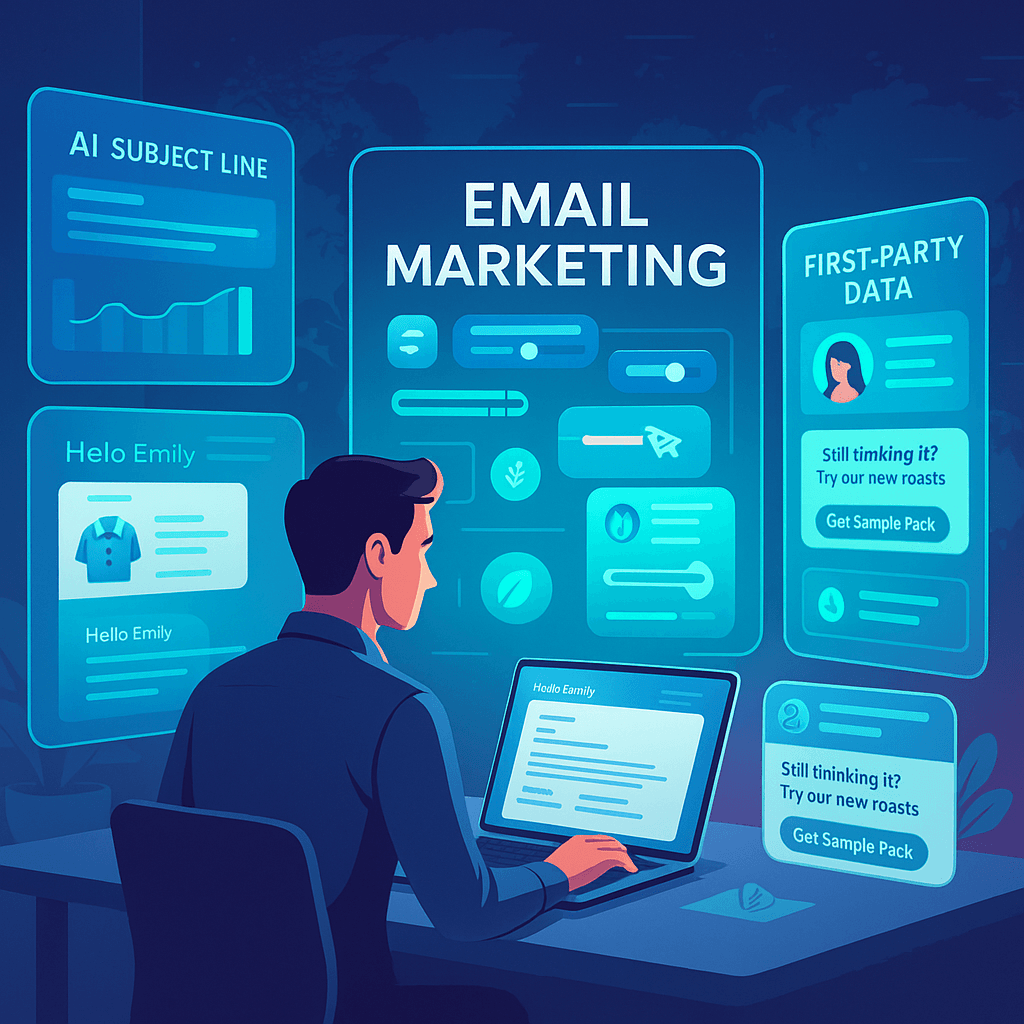Last month, I was having coffee with Sarah, a veteran marketing director who’s been in the industry for over 20 years. “You know what keeps me up at night?” she confessed, stirring her latte absently. “How quickly everything’s changed. When I started, we celebrated a 2% response rate on direct mail. Now I’m drowning in data points and still wondering if we’re reaching the right people.”
Sarah’s not alone. I’ve spent the last decade consulting with brands struggling to navigate this exact transition. The advertising landscape has undergone a seismic shift, and at its epicenter is data-driven advertising – something that’s revolutionized how we connect with audiences.
My Journey with Data-Driven Advertising
When I first entered marketing in 2015, we were already talking about data, but honestly? Most of us were just paying lip service to the concept. We’d collect basic analytics, maybe segment our email lists, and call it “data-driven.” Fast forward to 2025, and the sophistication is mind-blowing.
Today’s data-driven advertising isn’t just about having information – it’s about connecting thousands of behavioral signals to create deeply personalized experiences. It’s the difference between knowing someone visited your website and understanding they browse workout equipment every Sunday night after checking their calendar for the week ahead.
Beyond the Buzzwords: What Really Matters
Let’s cut through the jargon for a minute. At its heart, data-driven advertising is simply about paying attention. Imagine you run a small bookshop. Over time, you notice regular customers’ preferences – Jane always checks the historical fiction section first, while Tom heads straight for science books. You might casually mention a new release you think they’d enjoy. Data-driven advertising does this at scale, but instead of mental notes, we’re using sophisticated tracking and analysis.
I remember working with a small kitchenware brand that was hemorrhaging money on broad Facebook campaigns. After implementing basic data tracking, we discovered their actual buyers weren’t the young professionals they’d targeted but empty-nesters rediscovering cooking. Their entire strategy shifted overnight.
The Game-Changers in Your Toolkit
First-Party Data: Your Secret Weapon
Nothing has become more precious than the data you collect directly from your audience. With privacy changes rocking the industry (thanks, Apple and Google), the brands I’ve seen thriving are those who prioritized building direct relationships years ago.
A local fitness studio I work with started collecting simple workout preferences through their booking system in 2022. Today, they use that information to send perfectly timed class recommendations based on individual workout patterns. Their attendance has jumped 37% while their advertising costs dropped.
PPC: Not Your 2020 Strategy
Remember when you could set up some pay-per-click (PPC) keywords and call it a day? Those times feel ancient now. Modern PPC requires constant testing and refinement.
I recently audited a campaign for a furniture retailer who couldn’t figure out why their Google Ads weren’t converting. Turns out, they were bidding on the right keywords but completely missing the intent signals. Their ads showed to people researching styles, not those ready to purchase. By layering in behavioral targeting and adjusting their bidding strategy around high-intent moments, we tripled their conversion rate within weeks.
The Evolution of Retargeting
If you’re still using retargeting just to show the same product someone viewed, you’re leaving money on the table. The magic happens when you use that behavior as one data point in a larger story.
One e-commerce client struggled with cart abandonment for years. Rather than simply retargeting with the abandoned products, we created a system that analyzed abandonment patterns. Some customers responded to discount offers, others to free shipping, and surprisingly, many converted when shown complementary products instead. This nuanced approach increased their retargeting conversion by 58%.
Real Talk: The Benefits Worth Fighting For Breaking Through the Noise
I’ve lost count of how many ads the average person sees daily – estimates range from 4,000 to 10,000. In this cluttered environment, relevance isn’t just nice to have; it’s essential for survival.
Last year, I tracked my own ad exposure for a week (occupational hazard). The only ones I remembered were those that aligned perfectly with something I needed or was passionate about. That’s the power of proper data utilization.
Making Performance Marketing Actually Perform
Here’s a truth bomb: most performance marketing isn’t performing nearly as well as it could be. Why? Because marketers optimize for easy metrics rather than meaningful ones.
I watched a DTC brand obsess over reducing their cost-per-click for months, only to realize they were attracting more unqualified visitors. When they shifted to optimizing for customer lifetime value signals instead, their acquisition costs initially rose – but their customer retention improved dramatically. Six months later, their overall marketing ROI had increased by 42%.
The Human Connection (Ironically)
The most surprising benefit I’ve witnessed is how good data can make advertising feel more human, not less. When messaging arrives at the right moment with the right solution, it doesn’t feel like an intrusion – it feels like help.
My favorite example comes from a small travel company that used weather data, booking patterns, and social sentiment to identify people desperately needing vacation suggestions during particularly stressful weeks. Their campaign didn’t feel like advertising; it felt like a friend saying, “Hey, looks like you need a break. Have you considered this?”
The Challenges I’ve Battled (And How You Can Win)
The Privacy Paradox
Let’s address the elephant in the room: people want personalized experiences but are increasingly protective of their data. This tension creates genuine challenges.
I’ve watched brands panic as cookies crumbled and tracking became more restricted. The winners weren’t those with technical workarounds but those who created value exchanges that made customers willing to share information.
A beauty brand I advised created an innovative “skin profile” tool that provided personalized skincare advice. Users happily provided information because they received immediate value, which the brand then used (transparently) to tailor product recommendations.
Data Overload Is Real
Having worked across organizations of all sizes, I’ve seen firsthand that collecting data is easy – making sense of it is hard. Many marketers are drowning in information without extracting actionable insights.
Start small. Focus on one customer journey or problem. When a home goods client was overwhelmed by their analytics, we zeroed in exclusively on the path from Instagram to purchase. By deeply understanding that single pathway, we identified friction points invisible in broader analysis.
The Technical Knowledge Gap
I won’t sugarcoat it: doing data-driven advertising well in 2025 requires technical chops that many marketing teams lack. The most successful organizations I’ve worked with bridge this gap in one of three ways:
- Upskilling existing creative talent
- Hiring hybrid professionals who understand both marketing and data
- Creating collaborative processes between technical and creative teams
The Future of Pay-Per-Click Advertising (From Someone Who’s Been Wrong Before)
I should confess: back in 2020, I predicted voice search would dominate by 2023. It didn’t quite happen that way. So take my predictions with appropriate skepticism.
That said, the future of pay-per-click advertising clearly points toward increased automation with strategic human oversight. The platforms are getting smarter at optimization, but they still need human creativity and ethical guidance.
What excites me most is the potential for intent-based marketing that transcends keywords. I’m watching experiments with emotional response tracking and contextual relevance that could transform how we think about “clicking” entirely.
My Hard-Earned Advice for Implementation
If you’re feeling overwhelmed (and who isn’t?), here’s my practical advice after helping dozens of organizations navigate this transition:
- Start with questions, not tools. What do you actually need to know about your customers?
- Audit your first-party data collection before anything else
- Build one solid end-to-end system before expanding
- Test relentlessly, but give tests enough time to yield meaningful results
- Remember that all the data in the world can’t save boring creative
A Final Thought
Last week, I received a perfectly timed email from my favorite hiking gear shop. It suggested a waterproof cover for my backpack (which I had purchased from them six months earlier) right before a rainy season hiking trip I had been researching on their site. I bought it immediately.
That’s the potential of data-driven advertising in 2025 – not just to sell more stuff, but to solve problems people actually have, right when they have them. When we use data to serve rather than just to sell, everybody wins.
In an industry obsessed with the next shiny technology, I believe the real differentiator will be how humanely and helpfully we apply the data we have. The brands that remember there are real people behind every data point will be the ones that thrive in the years ahead.





